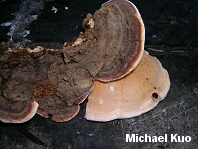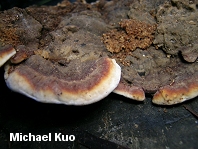| Major Groups > Polypores > Heterobasidion annosum |

|
Heterobasidion annosum [ Basidiomycetes > Russulales > Bondarzewiaceae > Heterobasidion . . . ] by Michael Kuo This root and butt rot fungus is a destructive pathogen, appearing as a parasite on conifers across the continent. It is especially destructive in conifer plantations and in thinned second-growth conifer forests, and it is well known to foresters as "annosus rot." Given enough time, Heterobasidion annosum can kill a tree by rotting its roots and trunkwood, making it very susceptible to windthrow. Distinguishing features for Heterobasidion annosum include its irregular, rough, brown to black cap, which features a whitish margin and, often, a reddish marginal zone; its whitish pore surface, composed of tiny (4-5 per mm) pores; its whitish flesh, which does not turn black or red with KOH; and microscopic features. The cap is sometimes absent, or present merely as a short extension above the pore surface. Fomitopsis pinicola can appear similar, but appears higher on the tree (or log) and usually has a more regularly shaped cap, as well as flesh that turns red in KOH. Fomes annosus, Fomitopsis annosa, and Polyporus annosus are synonyms. Description: Ecology: Parasitic on the wood of conifers (rarely on hardwoods) and saprobic on deadwood; causing a white pocket rot of the roots and butt; annual or perennial; growing alone or gregariously at the bases of trees; appearing year-round; widely distributed in North America but rare in the central Rocky Mountains. Fruiting Body: Variable: sometimes merely a spreading pore surface; sometimes with a folded-over edge of a cap; sometimes with a poorly to well developed cap. Cap: When present up to 25 cm across and 15 cm deep; shelf-like to kidney-shaped or irregular; finely velvety or bald; roughened and cracked; brown to dark brown or black, with a whitish margin and a reddish to reddish brown marginal zone; sometimes hosting moss or algae. Pore Surface: Creamy to pinkish, orangish, or yellowish; not bruising appreciably; with 4-5 circular to angular pores per mm; tube layers often indistinct, to 3 mm thick. Stem: Absent. Flesh: White; corky to woody. Odor: Not distinctive. Chemical Reactions: KOH negative on flesh. Spore Print: Presumably white. Microscopic Features: Spores 4.5-6.5 x 3.5-8 µ; smooth or very finely roughened; subglobose to ovoid; hyaline in KOH; inamyloid. Cystidia absent. Hyphal system dimitic; skeletal hyphae dextrinoid. REFERENCES: (Fries, 1821) Brefeld, 1888. (Overholts, 1953; Gilbertson & Ryvarden, 1986; Lincoff, 1992; Barron, 1999; Miller & Miller, 2006; Trudell & Ammirati, 2009.) This site contains no information about the edibility or toxicity of mushrooms. |
© MushroomExpert.Com |
|
Cite this page as: Kuo, M. (2010, March). Heterobasidion annosum. Retrieved from the MushroomExpert.Com Web site: http://www.mushroomexpert.com/heterobasidion_annosum.html |

